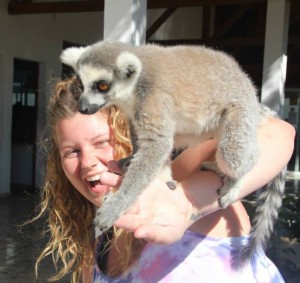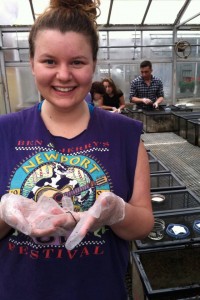After suffering through calculus and chemistry as an undeclared sophomore, I jumped at the opportunity to study abroad in Madagascar with Dr. Patricia Wright, the world’s foremost expert on the finest animals to vertically cling and leap across the rainforest canopy—lemurs. In Madagascar I experienced lots of firsts, like hiking, pooping on the ground, camping, and being hungry. I also started my very first research project with my good friend Hannah Manning (who is now a vet student at Ohio State University). Together, we investigated the correlation between Red Fronted Lemur vocalization frequency and group size. I loved every second of data collection and as the project progressed I knew I’d found what I was always meant to do. In many ways, however, Madagascar disappointed me. I watched deforested areas erupt into flames for slash-and-burn agriculture; I heard rumors of villains mining for gold within the park; I watched a critically endangered lemur cross a busy highway in the middle of the afternoon. I never wanted to forget the imminent dangers threatening the rainforest, so after study abroad ended, I continued to work with Dr. Patricia Wright. Even while she was in the middle of becoming a movie star (everybody should go watch IMAX’s Island of Lemurs ASAP), Dr. Wright always made time to answer my questions, critique/fix my work, and teach me about effective conservation.
Dr. Wright reminded me of the environment I left behind in Madagascar, while Dr. Sharon Pochron introduced me to the majestic qualities of (invasive) earthworms here on Long Island. In Dr. Pochron’s lab, we use earthworms to conduct research on the impacts of Cadmium and Roundup on mortality and soil microbial respiration. Dr. Pochron has united students from sustainabilities, biology, and chemistry to congregate in the (sometimes stinky) confines of the Life Sciences Greenhouse, where we work together to feed, water, count, and weigh earthworms exposed to varying concentrations of toxicants. I have enjoyed working with Dr. Pochron because she dares her students to write with active voices, to think like statisticians, and to try to keep Mo, her aspiring guide dog, from eating squirrels and poison.
As an undergraduate senior in the Anthropology major and Ecosystems and Human Impact minor, I’ve had the opportunity to learn from a unique synthesis of biology, primatology, writing, and conservation. My classes and research experiences have inspired me to become part of the solution our planet needs. So, next semester, I will be returning to Stony Brook University as a graduate student in the department of Ecology and Evolution. I look forward learning more about environmental issues, conservation policy, and quantitative system modeling. While pursuing my master’s degree, I will return to Madagascar to investigate the nutritional ecology of two sympatric lemur species in Ranomafana National Park. I also look forward to participating in future ecotoxicology studies in Stony Brook’s Greenhouse. After earning my masters, I will pursue my PhD in ecology, so that I can spend the rest of my life answering research questions that address climate change, ecosystem degradation, and species endangerment. Because of my education, I will be more than my carbon footprint.
 By Mariah Donohue
By Mariah Donohue
Sustainability Studies Program ’15
Anthropology Major
Ecosystems and Human Impact Minor



Travel agencies play a crucial role in organizing and planning trips, offering services ranging from flight bookings to guided tours. They provide expertise and convenience, ensuring travelers have smooth experiences. Many agencies also offer customized packages, catering to specific interests and budgets. However, customer service can sometimes be a challenge, with some travelers expressing dissatisfaction. For example, issues related to booking errors or poor communication are often highlighted on review sites like https://trip-com.pissedconsumer.com/customer-service.html. Despite this, many customers still prefer using agencies for their trips, valuing the ease and support they provide during travel planning and logistics.
MarQi Blinds offers a premium selection of blinds and shades designed to enhance both residential and commercial interiors. From elegant sheer and zebra shades to practical blackout and vertical blinds, each product combines style with functionality. Manufactured in the USA with top-tier materials and Somfy motorization options, MarQi ensures fast delivery and exceptional quality. Serving multiple states, they provide tailored window treatments to suit any décor.
MarQi Blinds offers a premium selection of blinds and shades designed to enhance both residential and commercial interiors. From elegant sheer and zebra shades to practical blackout and vertical blinds, each product combines style with functionality. Manufactured in the USA with top-tier materials and Somfy motorization options, MarQi ensures fast delivery and exceptional quality. Serving multiple states, they provide tailored window treatments to suit any décor.